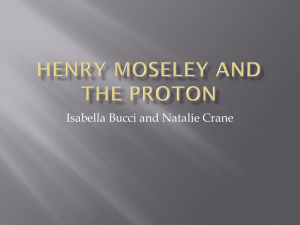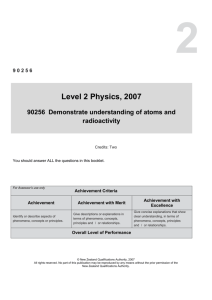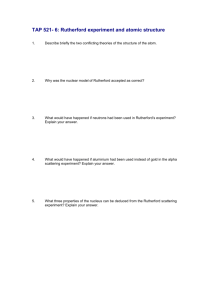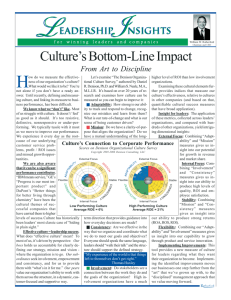Hexagon Fall - Department of Chemistry
advertisement
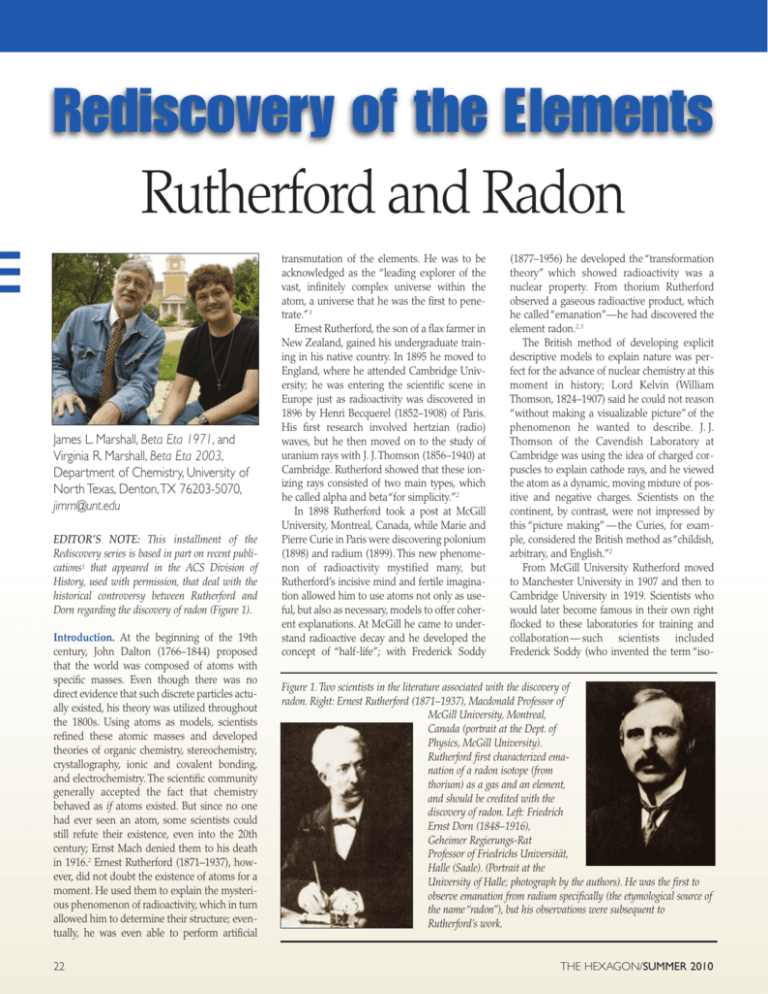
III Rediscovery of the Elements Rutherford and Radon James L. Marshall, Beta Eta 1971, and Virginia R. Marshall, Beta Eta 2003, Department of Chemistry, University of North Texas, Denton, TX 76203-5070, jimm@unt.edu EDITOR’S NOTE: This installment of the Rediscovery series is based in part on recent publications 1 that appeared in the ACS Division of History, used with permission, that deal with the historical controversy between Rutherford and Dorn regarding the discovery of radon (Figure 1). Introduction. At the beginning of the 19th century, John Dalton (1766–1844) proposed that the world was composed of atoms with specific masses. Even though there was no direct evidence that such discrete particles actually existed, his theory was utilized throughout the 1800s. Using atoms as models, scientists refined these atomic masses and developed theories of organic chemistry, stereochemistry, crystallography, ionic and covalent bonding, and electrochemistry. The scientific community generally accepted the fact that chemistry behaved as if atoms existed. But since no one had ever seen an atom, some scientists could still refute their existence, even into the 20th century; Ernst Mach denied them to his death in 1916.2 Ernest Rutherford (1871–1937), however, did not doubt the existence of atoms for a moment. He used them to explain the mysterious phenomenon of radioactivity, which in turn allowed him to determine their structure; eventually, he was even able to perform artificial 22 transmutation of the elements. He was to be acknowledged as the “leading explorer of the vast, infinitely complex universe within the atom, a universe that he was the first to penetrate.” 3 Ernest Rutherford, the son of a flax farmer in New Zealand, gained his undergraduate training in his native country. In 1895 he moved to England, where he attended Cambridge University; he was entering the scientific scene in Europe just as radioactivity was discovered in 1896 by Henri Becquerel (1852–1908) of Paris. His first research involved hertzian (radio) waves, but he then moved on to the study of uranium rays with J. J. Thomson (1856–1940) at Cambridge. Rutherford showed that these ionizing rays consisted of two main types, which he called alpha and beta “for simplicity.”2 In 1898 Rutherford took a post at McGill University, Montreal, Canada, while Marie and Pierre Curie in Paris were discovering polonium (1898) and radium (1899). This new phenomenon of radioactivity mystified many, but Rutherford’s incisive mind and fertile imagination allowed him to use atoms not only as useful, but also as necessary, models to offer coherent explanations. At McGill he came to understand radioactive decay and he developed the concept of “half-life”; with Frederick Soddy (1877–1956) he developed the “transformation theory” which showed radioactivity was a nuclear property. From thorium Rutherford observed a gaseous radioactive product, which he called “emanation”—he had discovered the element radon.2,3 The British method of developing explicit descriptive models to explain nature was perfect for the advance of nuclear chemistry at this moment in history; Lord Kelvin (William Thomson, 1824–1907) said he could not reason “without making a visualizable picture” of the phenomenon he wanted to describe. J. J. Thomson of the Cavendish Laboratory at Cambridge was using the idea of charged corpuscles to explain cathode rays, and he viewed the atom as a dynamic, moving mixture of positive and negative charges. Scientists on the continent, by contrast, were not impressed by this “picture making” — the Curies, for example, considered the British method as “childish, arbitrary, and English.”2 From McGill University Rutherford moved to Manchester University in 1907 and then to Cambridge University in 1919. Scientists who would later become famous in their own right flocked to these laboratories for training and collaboration — such scientists included Frederick Soddy (who invented the term “iso- Figure 1. Two scientists in the literature associated with the discovery of radon. Right: Ernest Rutherford (1871–1937), Macdonald Professor of McGill University, Montreal, Canada (portrait at the Dept. of Physics, McGill University). Rutherford first characterized emanation of a radon isotope (from thorium) as a gas and an element, and should be credited with the discovery of radon. Left: Friedrich Ernst Dorn (1848–1916), Geheimer Regierungs-Rat Professor of Friedrichs Universität, Halle (Saale). (Portrait at the University of Halle; photograph by the authors). He was the first to observe emanation from radium specifically (the etymological source of the name “radon”), but his observations were subsequent to Rutherford’s work. THE HEXAGON/SUMMER 2010 Figure 2. Near the Roddick Gates on Rue Sherbrooke in Montreal, Canada, is this statue of James McGill (1744–1813), whose bequest was responsible for the founding of McGill University in 1821. The plaque at the base is inscribed in both English and French. McGill won his fortune in the fur trade and went on to other enterprises in property. He was born in Glasgow, Scotland, and was educated at the University of Glasgow, where a plaque exists in his honor recognizing his achievements in Canada. (See next figure). tope”), Niels Bohr (who first described the quantized atom), Otto Hahn (who discovered atomic fission), Henry Moseley (who discovered atomic numbers from his X-ray research), Georg von Hevesy (who discovered hafnium), James Chadwick (who discovered the neutron), and Hans Geiger (famed for his eponymous counting device). Rutherford was a giant in his field and was mourned at his premature death at the age of 66 at Cambridge.2,3 Rediscovering Rutherford in McGill. Rutherford’s Nobel Prize in 1908 was given in recognition of his work at McGill University (Figures 2,3), an English-speaking university in the center of Montreal, Canada (see Figure 4). The building where Rutherford and Soddy performed their work, then called the Macdonald Physics Building (Figure 5), still stands (Figure 6). Nearby is the Rutherford Physics Building, where a beautiful and complete Rutherford Museum has been established which in fine detail describes the experiments performed at McGill University. The exhibits include cases demonstrating “The Nature and Properties of ␣-rays,” “Emanations from Thorium and Radium,” “Excited Radioactivity,” “Ionization Studies,” “Heating Effectings of Radiation,” “The Radium Decay Series,” “Measurement Techniques,” “Various Documents,” and SUMMER 2010/THE HEXAGON Figure 4. Map of McGill area of Montreal, Canada. Rue [street] University which leads northwest into the university is a continuation of Interstate 10. Macdonald Physics Building (the old Physics Building), where Rutherford performed his work, then MacdonaldStewart Library, now called the Shulich Library (Engineering and Science), 809, rue Sherbrooke Ouest—N45° 30.30 W73° 34.49. Rutherford Building (Modern Physics Building), which holds the Rutherford Musum, 3600 rue University—N45° 30.41 W73° 34.72. “1” = James McGill statue, close to Roddick Gates—N45° 30.25 W73° 34.54. “2” = Otto Maass Chemistry Building, modern chemistry building, 801, rue Sherbrooke Ouest—N45° 30.31 W73° 34.46. “3” [in inset] = Rutherford home during 1900–1907, then No. 152 Rue Sainte Famille Street, now 3702 Rue Sainte Famille (corner of Rue Ste Famille and Rue Basset)—N45° 30.75 W73° 34.58. “4” [in inset] = Rutherford Building (Modern Physics Building)—for reference in the inset, same as above. “Photographs.” The creator of the museum was Dr. Ferdinand Terroux, a student of Rutherford at Cambridge University, who came to McGill in 1931, where he became professor of physics. Dr. Terroux established the museum in 1967 after he assembled Rutherford’s apparatus and equipment, which had been in storage for many decades. The modern museum reputedly houses the world’s best collection of Rutherford apparatus. Two figures presented here show only a meager sampling of the richness of the Figure 3. In the Cloisters of Glasgow University is this plaque (N55° 52.26 W04° 17.33) devoted to McGill. Nearby (200 meters northwest; N55° 52.37 W04° 17.45) is a plaque commemorating the site where Soddy, who earlier was a postdoctoral fellow for Rutherford in McGill University, originated the term “isotope” in 1913 at a dinner party held by his parents-in-law. museum (Figures 7 and 8). In the alcove outside the museum is a bust and plaque in honor of Rutherford (Figure 9), and inside the Otto Maass Chemistry Building is a plaque devoted to Soddy (Figure 9). An incorrect ascription of radon’s discovery. In the literature Friedrich Ernst Dorn is commonly, but incorrectly, ascribed as the discoverer of radon; for example, presented for decades in the Handbook of Chemistry and Physics is this statement: 4 a,c “The element [radon] was discovered in 1900 by Dorn, who called it radium emanation.” This error has been repeated countless times in subsequent articles, books, and web sites. In fact, Dorn did not first give the name of “emanation” to the phenomenon (much less “radium emanation”); he did not have the faintest idea of the nature of the phenomenon, and he certainly did not realize that it might be a new element (Note 1). What was the source of the error? Here is the story: A difficulty in assigning proper credit of radon’s discoverer was recognized by Partington5 who identified an erroneous citation by George Charles de Hevesy (1888–1866).6 In Hevesy’s paper, an incorrect reference was given to Dorn’s original paper 7 where radium was observed to produce an emanation; this faulty reference was copied into all subsequent works of reference until Partington corrected the error 44 years later.5 In the meantime, Dorn’s paper apparently was not widely read and its exact contents were lost in time (Note 2). 23 III The original paper of Dorn, “Die Von Radioaktiven Substanzen Ausgesandte Emanation” [“The radiated emanation from radioactive substances”],7 was published in the insular journal Abhandlungen der Naturforschenden Gesellschaft (Halle) [“Treatises of the Scientific Society of Halle”], which recorded the readings of colleagues as they met in informal local gatherings to present their recent research. To obtain a copy of this obscure article and other associated literature, the authors traveled to Halle (Saale) (Figure 10) and located the journal in the Deutsche Akademie der Naturforscher Leopoldina [Leopold Germany Academy of Sciences], Emil-Abderhalden-Str. 37 (N51° 29.33 E11° 58.22). Once in hand, the paper began with a reference to Rutherford’s original discovery 8 of the emanation from thorium: “Rutherford noticed that a sweeping stream of air over thorium or thorium compounds, even after being filtered through cotton, has the property of discharging an electroscope... . Rutherford said that other radioactive substances (such as uranium) did not exhibit the same properties as thorium... . I have adopted the approach of Rutherford and have taken a second look at other radioactive substances available locally at our Institute [Friedrichs Universität, now the Martin-Luther Universität Halle-Wittenberg].” Dorn’s paper7 continued with an elaborate pastiche of experiments covering uranium, thorium, radium (in the form of crude radioactive barium), and polonium (crude radioactive bismuth). Dorn repeated Rutherford’s procedure, explicitly using Rutherford’s design of apparatus, and found that indeed uranium and polonium did not display the “emanation”phenomenon of thorium, but that radium did. In his study, Dorn examined principally the influence of moisture and heat on activity: “It appears to me that there is a strong dependence between the emanation and the secondary activity upon the amount of moisture, [but] I have not found a universally valid relation.” In his paper Dorn makes no speculation regarding the nature of the emanation, except that the phenomenon apparently concerned “a physico-chemical process.” (In subsequent years Dorn published no more on “emanation,” except for two inconsequential student dissertations 9). Dorn had stumbled onto the isotope of radon (Rn-222)10 that was the easiest to investigate with its “long” half-life of 3.823 days.4b The isotope that emanated from thorium (Rn220)10 previously observed by Rutherford, with its half-life of about 55.6 seconds,4b was more difficult to study. (Actinium was later observed by André-Louis Debierne (1874–1949) to produce an emanation as well;11 this isotope, Rn-219, had an even shorter half-life of 3.96 seconds4b). 24 Figure 5. The Macdonald Physics Building, built in 1893, five years before Rutherford arrived. This is the appearance of the building at the time of Rutherford. The benefactor Sir William Christian Macdonald (1831–1917) was a tobacco magnate who donated generous sums of money to McGill University and other charitable organizations, often directly to Rutherford himself. The view is northwest. Figure 6. This was the appearance of the Macdonald Physics Building in 2000, at the time of the authors’ visit. It was then being remodeled, and today serves as the Schulich Library for Engineering and Science. As is common in all urban settings, this historic site has become surrounded and cramped by other buildings (the building to the left is Burnside Hall, serving Atmospheric and Oceanic Sciences). The view is northwest. Although the nature of the emanation was not contemplated seriously by Dorn, it certainly was by Rutherford and the Curies. By 1903 Mme. Curie (the first to notice the phenomenon) stated, in the first edition of her thesis,12b “Mr. Rutherford suggests that radioactive bodies generate an emanation or gaseous material which carries the radioactivity. . . . [Instead we] consider the emanation as radioactive energy . . . in a form hitherto unknown.”13 In a private note to Rutherford, Mme. Curie thought the phenomenon might be a form of “phosphores- cence.”14 This “radioactive energy” was baffling; vague descriptions were offered, for example, that they were “centers of force attached to molecules of air.”15 Rutherford vigorously attacked the problem, considering explanations that included not only phosphorescence, but also deposition of gaseous ions, deposition of radioactive particles, stray dust, etc.14 Eventually he and his colleague Frederick Soddy were able to show that not only did the emanation pass unscathed through a physical barrier such as cotton or water, but also through chemical barTHE HEXAGON/SUMMER 2010 Figure 7. This was Dr. Montague (Monty) Cohen, curator of the museum, now deceased (29-012002). In this photograph, Monty is standing before the exhibit concerning Rutherford’s discovery of radon, which is “Case B” of the museum. Figure 8. In one of his pioneering researches, Rutherford first demonstrated the prodigious amount of heat generated by radioactivity. Using this differential air calorimeter (where two flasks were connected by a manometer), a known mass of radium is inserted in the right flask and a resistance wire in the left flask. The heat was adjusted in the resistance wire on the left so that xylene in the manometer (indicating relative pressure in the two flasks) is balanced by equally heated air in both flasks. The amount of heat generated by the radium (1 gram) was calculated to be 110 gramcalories/hour, enormously greater than that generated in chemical reactions. Rutherford expanded this experiment to separate out the contributions of gamma radiation (using lead shielding) and emanation (by purging of the flasks). riers such as P2O5, sulfuric acid, lead chromate, heated magnesium, and even “platinum heated to incipient fusion”;16 and that it obeyed Boyle’s law, could be condensed out, and thus behaved just like a gas.17 By 1903 they could claim that the “emanation” must be matter in the gaseous state.18 By the next year Mme. Curie herself agreed with Rutherfords’s conclusions.15 By 1920 the literature was filled with a mélange of names for the radioactive gaseous element, including “niton” with the chemical symbol Nt (niton was the “official” entry in SUMMER 2010/THE HEXAGON Figure 9. Left: Bust of Rutherford in the alcove of the Rutherford Physics Building. Right: Plaque devoted to Soddy is in the Otto Maass Chemistry Building. Soddy has sometimes been described as “Rutherford’s great discovery in McGill.” Chemical Abstracts), “emanation” with the chemical symbol Em, radon with Rn, thoron with Tn, actinon with At, and of course “radium emanation”—and generally a reader of the literature wasn’t sure whether one was dealing with the general element or with a specific isotope. In 1923 the International Committee on Chemical Elements noted10 that “the Committee has found it necessary to modify the nomenclature of several radioactive elements. . . Radon replaces the names radium emanation and niton.” The proper recognition of the “true discoverer” of an element has not always been straightforward. The recent play Oxygen, for example, skillfully demonstrates how claims of element discoveries may be ambiguous.19 The criteria used in such claims have evolved over the years — for example, in pre-Lavoisier times chlorine has been credited to Scheele in 1774 on the basis of his description of a crude mixture, even though its true nature was first recognized in 1810 by Davy, who gave it its present name.12a During the 1800s, a blend of increasingly rigorous criteria was demanded, including isolation of the element, recognition of it as an element, determination of its relative atomic mass, and acquisition of spectroscopic data. Thomas Thomson (1773–1852), who wrote the comprehensive History of Chemistry in the early 19th century, reminded us that “For it is not the man who forms the first vague notion of a thing that really adds to the stock of our knowledge, but he who demonstrates its truth and accurately determines its nature.”20 By 1900 rigid criteria were in practice for a claim of the discovery of an element—and by these criteria it is clear that Rutherford owns the credit for radon. Legacy of Rutherford in McGill. Rutherford’s realization that the radioactive process involves transmutation of the elements introduced the scientific world to 20th century nuclear chemistry. The importance and excitement of this accomplishment is summarized by Oliver Sacks in Uncle Tungsten:21 The Curies (like Becquerel) were at first inclined to attribute [radium’s] “induced radioactivity” [in everything around them] to something immaterial, or to see it as “resonance,” perhaps analogous to phosphorescence or fluorescence. But there were also indications of a material emission. They had found, as early as 1897, that if thorium was kept in a tightly shut bottle its radioactivity increased, returning to its previous level as soon as the bottle was opened. But they did not follow up on this observation, and it was Ernest Rutherford who first realized the extraordinary implication of this: that a new substance was coming into being, being generated by the thorium; a far more radioactive substance than its parent. Rutherford enlisted the help of the young chemist Frederick Soddy, and they were able to show that the “emanation” of thorium was in fact a material substance, a gas, which could be isolated. . . . Soddy [wrote later]. . .“I remember quite well standing there transfixed as though stunned by the colossal impact of the thing and blurting out. . . . ‘Rutherford, this is transmutation. . . .’ Rutherford’s reply was . . . ‘For Mike’s sake, Soddy, don’t call it transmutation. They’ll have our heads off as alchemists.’ ” For the next Rediscovery article, we will visit Rutherford’s laboratory in Manchester, England, where he discovered the atomic nucleus, and where Henry Gwyn-Jeffreys Moseley (1887–1915) formulated the concept of atomic numbers. Acknowledgments. The authors are indebted to Professor Montague Cohen, curator of the Rutherford Museum at the Department of Physics, McGill University, for his hospitality and for valuable information regarding the careers of Ernest Rutherford and Frederick Soddy. Sadly, Professor Cohen passed away in 2002. We are 25 III Figure 10. Physikalisches Institut Building of Friedrichs Universität, Friedemann-Bach-Platz, (as of 1933, the Martin-Luther Universität HalleWittenberg), Halle, Sachsen-Anhalt, Germany, where Dorn detected emanation from radium (N51° 29.20 E11° 57.88). He performed his studies on the stairs leading to the basement, where his reaction vessels stood while radium emanation diffused into various solutions and gelatin. A biography24 of Dorn describes a “Renaissance Man” who published in geophysical studies, mathematics, liquid crystals, the biological effects of X-rays, and various other electrical-mechanical studies, developing an impressive reputation in applied physics. also grateful to Dr. Monika Plass and Dr. Alfred Kolbe (retired) of the Institut für Physikalische Chemie, Martin-Luther Universität HalleWittenberg, for guiding us about the important sites in Halle and for procuring pertinent documents at the university library and archives of the Deutsche Akademie der Naturforscher Leopoldina. Also acknowledged is Dr. John Campbell of the University of Canterbury, Christchurch, New Zealand, an expert on the life of Ernest Rutherford, who has graciously furnished important clarifying details regarding the life of the Nobel Laureate Ernest Rutherford, and who perhaps was the first to proclaim specifically that Rutherford was the true discoverer of radon.3 showed that one of the disintegration products of radium is a gas. This was at first called radium emanation... . ” One can trace erroneous citations for Dorn’s article7 beginning even with Rutherford in 1902,26 throughout the 20th century, including Dorn’s 1990 biography24 published at Halle! Why should so many sources make this mistake? A possible source of the problem was suggested [Dr. Monika Plass, private communication] that the bound volume at Halle labeled v. 22, year 1900 also contains v. 23, year 1901 (also leading unfortunately to an incorrect cited year in the author’s original publication1a). A careful search reveals that Dorn published nothing on emanation prior to volume 23, year 1901. Notes. References. Note 1. An example of the many incorrect ascriptions of Dorn’s “discovery of radon” is found on the Wikipedia web site for “Radon.”22a It is gratifying to notice, however, that the Wikipedia web site entry for “Friedrich Ernst Dorn”22b has been corrected, giving proper credit to Rutherford. The incorrect ascription of the discovery of radon to Dorn was briefly noted in the earlier complete biography of Rutherford by John Campbell,3 and later was recognized in the biography by John L. Heilbron.2 Modern treatises of the elements which are carefully researched, such as the voluminous Encyclopedia of the Elements,23 or Oliver Sacks’ Uncle Tungsten,21 chronicle the correct sequence of events regarding the discovery of radon. 1. J. L. Marshall and V. R. Marshall, Bull. Hist. Chem., (a) 2003, 28(2), 76–83; (b) 2004, 29(2), 112–114. 2. J. L. Heilbron, Ernest Rutherford and the Explosion of Atoms, 2003, Oxford University Press. 3. J. Campbell, Rutherford. Scientist Supreme, 1999, AAAS Publications, Christchurch, New Zealand. 4. For example, (a) CRC Handbook of Chemistry and Physics, 64th ed., ed.-in-chief, R. C. West, 1984, The Chemical Rubber Publishing Company, Boca Raton, FL, B-33; (b) B-298; (c) ibid, ed.-in-chief, C. D. Hodgman and H. N. Holmes, 1941, CRC, Cleveland, Ohio, 300. 5. J. R. Partington, Nature, 1957, 179, 912. 6. G. von Hevesy, Jahrb. Radioakt. Elektron., 1913, 10, 198–221. 7. E. Dorn, Abhandlungen der Naturforschenden Gesellschaft (Halle), 1901, 23, 1–15. 8. E. Rutherford, Philos. Mag., 1900, 5.Ser., 49, 1–14. Note 2. For a century the reference to Dorn’s article was cited as Abh. Naturf. Ges. (Halle), 1900, 22, 155 (or sometimes 115) instead of the correct 1901, 23, 1–15. It is clear that Weeks, the well-known author of Discovery of the Elements, had not read Dorn’s publication7 when she gravely misreported its contents:25 “The correct explanation was given by Dorn. . . . [He] 26 9. F. Wallstabe,“Untersuchungen über die Emanation des Radiums,” 1903, and A. Jahn, “Über Diffusion von Radium Emanation in wasserhalitige Gelatine,” 1914 (both Inaugural Dissertations, Friedrichs Universität). These dissertations dealt with the diffusion of “emanation” in solutions and gelatins, respectively, with no interpretations beyond explanations already published by Rutherford. 10. F. W. Aston, G. P. Baxter, B. Brauner, A. Debierne, A. Leduc, T. W. Richards, F. Soddy, and G. Urbain, J. Am. Chem. Soc., 1923, 45, 867–874. 11. A. Debierne, Compt. rend., 1904, 138, (Feb. 15), 411–414. 12. J. R. Partington, A History of Chemistry, Macmillan, London, Vol. 4, 1964, (a) 51–57; (b) 942. 13. M. S. Curie, Chem. News. J. Ind. Sci., 1903, (Nov. 13), 235–236. 14. E. Rutherford, Philos. Mag., 1900, 5.Ser., 49, 161–192. 15. E. Rutherford, Radioactive Transformations, Ch. III,“The Radium Emanation,” Yale University Press, New Haven, CT, 1906, p 70–94 (alternate publisher: C. Scribner’s Sons). 16. E. Rutherford and F. Soddy, Philos. Mag., 1903, 6.Ser., 5, 445–457. 17. E. Rutherford and F. Soddy, Proc. Chem. Soc. London., 1902, 219–220. 18. E. Rutherford and F. Soddy, Philos. Mag., 1903, 6.Ser., 5, 561–576. 19. Oxygen, C. Djerassi and R. Hoffman, 2001,Wiley-VCH, Weinheim, FRG. 20. T. Thomson, The History of Chemistry, 1975, Arno Press, N.Y., reprint of 1830-31 edition, Colborn and Bentley, London, Vol. II, 96. 21. O. Sacks, Uncle Tungsten, 2001, Alfred A. Knopf, New York, 282. 22 (a) http://en.wikipedia.org/wiki/Radon, (b) /Friedrich_Ernst_Dorn. 23. Per Enghag, Encyclopedia of the Elements, 2004, Wiley-Verlag GmbH & Co. KGaA, Weinheim, Germany, 1147, 1189. 24. 100 Jahre Gebäude des Physikalischen Institute in Halle—Die hallesche Physik am Ausgang des 19. Jahrhunderts, MartinLuther-Universität Halle-Wittenberg Wissenschaftliche Beiträge 1990/33 (O32), Halle (Saale), 1990, 22–32. 25. M. E. Weeks, Discovery of the Elements, 7th ed., 1968, Journal of the Chemical Education, Easton, PA, 785. 26. E. Rutherford and H. T. Brooks, Philos. Mag., 1902, 5.Ser., 4, 1–23. THE HEXAGON/SUMMER 2010


